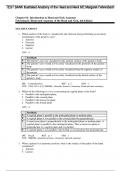Tentamen (uitwerkingen)
Test Bank for Illustrated Anatomy of the Head and Neck, 6th Edition by Margaret Fehrenbach. A+ Grade Full Chapters.
- Vak
- Instelling
Tb, Test Bank for Illustrated Anatomy of the Head and Neck, 6th Edition by Margaret Fehrenbach. ISBN: 9780323613019. Illustrated Anatomy of the Head and Neck 6e test bank. Fehrenbach 6e test bank for Illustrated Anatomy of the Head and Neck.
[Meer zien]




